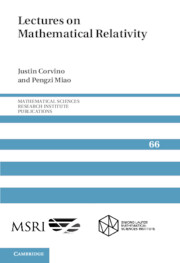Book contents
- Frontmatter
- Dedication
- Contents
- Preface
- Notation and conventions
- Chapter 1 Special relativity and Minkowski spacetime
- Chapter 2 The Einstein equation
- Chapter 3 Basics of Lorentzian causality
- Chapter 4 The Penrose singularity theorem
- Chapter 5 The Einstein constraint equations
- Chapter 6 Scalar curvature deformation and the Einstein constraint equations
- Chapter 7 Asymptotically flat solutions of the Einstein constraint equations
- Chapter 8 On the center of mass and constant mean curvature surfaces of asymptotically flat initial data sets
- Chapter 9 On the Riemannian Penrose inequality
- References
- Index
- References
References
Published online by Cambridge University Press: 03 April 2025
- Frontmatter
- Dedication
- Contents
- Preface
- Notation and conventions
- Chapter 1 Special relativity and Minkowski spacetime
- Chapter 2 The Einstein equation
- Chapter 3 Basics of Lorentzian causality
- Chapter 4 The Penrose singularity theorem
- Chapter 5 The Einstein constraint equations
- Chapter 6 Scalar curvature deformation and the Einstein constraint equations
- Chapter 7 Asymptotically flat solutions of the Einstein constraint equations
- Chapter 8 On the center of mass and constant mean curvature surfaces of asymptotically flat initial data sets
- Chapter 9 On the Riemannian Penrose inequality
- References
- Index
- References
- Type
- Chapter
- Information
- Lectures on Mathematical Relativity , pp. 383 - 394Publisher: Cambridge University PressPrint publication year: 2025

